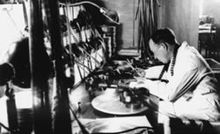Konstantin Märska
Konstantin Märska (born May 16 . Jul / 28. May 1896 greg. In Kuressaare on the island of Saaremaa ; † the thirtieth August 1951 in Tallinn ) was an Estonian film director. He is considered a pioneer of film art in Estonia .
Life and film
Konstantin Märska was born as the son of Anton (1862–1937) and Liisi Märska (née Teder, 1864–1935), the fourth of six children. At the age of fifteen, Märska began his film career as an assistant to a projectionist in a cinema in Kuressaare . At that time he was already making his first recordings with a self-made camera.
Together with his older brother Theodor Märska (1889–1961) he founded the film company Estonia-Film in 1919 . Brothers Johannes and Peeter Parikas contributed the capital . The company operated until bankruptcy in 1932.
In 1921 he produced what is probably the second feature film in Estonian film history, the comedy Armastuse pisielukas . In 1924 he worked as a cameraman with Mineviku varjud, the first long silent film in Estonian film history. The historical drama is now considered lost. From 1925 Märska worked for UFA and Paramount in Germany as a cameraman for the newsreels. In the summer of 1928 he returned to Estonia from Berlin.
At the end of the 1920s, Märska made three more silent films in Estonia with his own company, Konstantin Märska Filmiproduktsioon . They were followed in 1930 by the feature film Kuldämblik, directed by Boris Jaanikosk . The strip with its vocal interludes was the first attempt at an Estonian sound film. The sound was played on gramophone records in the cinema. However, due to its technical inadequacies, the film was a flop.
Then Märska withdrew from the feature film business. He took a job at the Tallinn film studio Eesti Kultuurfilm, founded in 1931 . There he specialized in newsreels and documentaries as well as reports. In 1936/37 he made ethnological observations in the southeast Estonian Petserimaa ( Pühad Petseris ) and on the island of Osmussaar ( Vaated Osmussaarelt ).
In 1938/39 Märska shot as a cameraman in Finland . This is where the Isoviha and Simo Hurtta strips were created .
In 1941 Märska was employed by the Estonian newsreel Kinokroonika . He stayed in the country even after the Soviet occupation of Estonia. In 1947 he was taken over by the state-owned Soviet-Estonian film company Tallinna Kinostuudio . Märska was the second cameraman of the first Estonian feature film after World War II , Elu tsitadellis , directed by Herbert Rappaport .
Märska then concentrated primarily on documentaries, mostly on natural topics. For his documentary Eesti põlevkivi ("The Estonian Oil Shale ") he received the 1949 Estonian SSR Prize .
Private life
Konstantin Märska married Hilda Treifeldt (1901–1966) in December 1919. The couple had two daughters.
Märska died in 1951 at the age of only 55. He is buried in the Rahumäe cemetery in the Estonian capital.
Filmography (selection)
- 1921: Armastuse pisielukas
- 1924: Õnnelik korterikriisi lahendus
- 1924: Mineviku varjud
- 1929: Dollarid
- 1929: Vigased pruudid
- 1929: Jüri Rumm
- 1930: Kuldämblik
- 1936: Pühad Petseris
- 1937: Vaated Osmussaarelt
- 1937: Nobedate Näppude linn
- 1939: Isoviha
- 1940: Simo Hurtta
- 1948: Eesti põlevkivi
- 1949: Hülgepüük
- 1950: Nõukogude Eesti kalurid
- 1951: Rünnak soodele
literature
- Eesti elulood. Tallinn: Eesti entsüklopeediakirjastus 2000 (= Eesti Entsüklopeedia 14) ISBN 9985-70-064-3 , p. 314
Web links
- Short biography (Estonian)
- Complete filmography
- Konstantin Märska in the Internet Movie Database (English)
Individual evidence
| personal data | |
|---|---|
| SURNAME | Märska, Konstantin |
| BRIEF DESCRIPTION | Estonian film director |
| DATE OF BIRTH | May 28, 1896 |
| PLACE OF BIRTH | Kuressaare |
| DATE OF DEATH | August 30, 1951 |
| Place of death | Tallinn |

